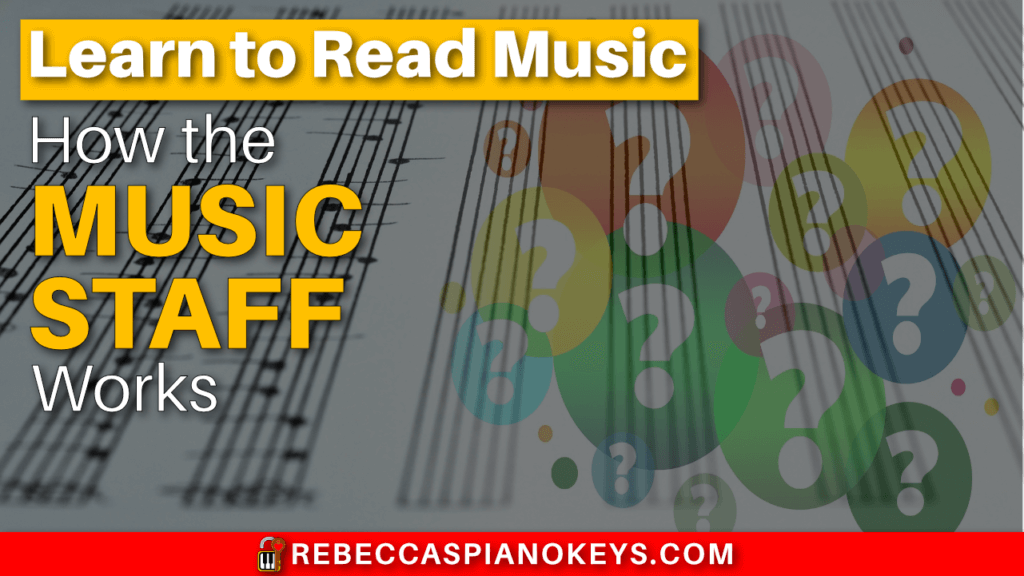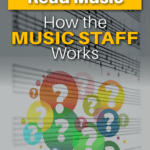Last Updated on January 10, 2023 by Rebecca
If you want to read music and also be able to notate your own compositions and/or arrangements, the first thing you need to learn is how the music staff works.
Obviously, you're excited to learn how to read notes.
But before you learn the notes themselves, you have to learn how the staff works. You have to learn to understand how the system of lines and dots and clefs all works.
(Which is what you'll learn in this post!)
Then you should learn how to read rhythms.
Then, you'll finally be ready to start learning which dots represent which keys on the piano.
(Oh, and by the way, before learning any of these things, you should take some time to learn and memorize the layout of the keys… if you haven't already.)

The 3 Music Staves Every Piano Player Must Learn
When playing piano, there are 3 staves you need to learn: the treble staff, the bass staff, and the grand staff.
The treble staff is a set of 5 lines and 4 spaces, marked with a treble clef.
We count both the lines and spaces from the bottom to the top. So the bottom line is the first line, and top line is the 5th line; the bottom space is the first space, and the top space is the 4th space.

The bass staff is a set of 5 lines and 4 spaces, marked with a bass clef.
In the bass staff, we also count the lines and spaces from the bottom to the top. So, once again, the bottom line is the first line and the top line is the 5th line; the bottom space is the first space and the top space is the 4th space.

The grand staff is what you get when you combine the treble staff with the bass staff.

Since the treble staff represents the treble notes, which have a higher pitch, it's found at the top of the grand staff.
And since the bass staff represents the bass notes, which have a lower pitch, it's found at the bottom of the grand staff.
Middle C
Middle C is significant because on the grand staff, it is exactly in the middle between the treble and bass staves.
When I was a child, my piano teacher always called the white space between the staves “Middle C's Playground.”
So middle C can be found floating below the treble staff on a ledger line, or it can be found floating above the bass staff on a ledger line. (In either case, you play exactly the same note on the piano.)
A ledger line is a small line used to extend the music staff to include higher or lower pitches.
The most common ledger line is the one used to represent middle C. You can see ledger lines passing through the 2 examples of middle C in the diagram below.

You can find middle C on the piano by counting 4 Cs up from the bottom of your keyboard, or 4 Cs down from the top of your keyboard.
(For an easy visual cue, if your piano has a brand name or logo on it, middle C is usually just below it.)
Fun Piano Fact
Middle C is called “middle C” because out of all the Cs on the piano, it is the one in the middle.
But it's not the middle key on the piano!
There actually is no middle key at all!
Since the piano has 88 keys, they divide evenly in half, with 44 on each side. So the actual middle of the piano is the space between the E and F just above middle C.
How Notes Fit on the Music Staff
Each line and each space on the music staff represents a different pitch, each with a corresponding key on the piano.

The higher a note is located on a staff, the higher its pitch. So as you move up the staff, you move up in pitch, and you therefore move to the right on the piano keys.
The lower a note is located on a staff, the lower its pitch. So as you move down the staff, you move down in pitch, and you therefore move to the left on the piano keys.
Notes on the treble staff are usually (but not always!) played with the right hand, and notes on the bass staff are usually (but not always!) played with the left hand.
This diagram helps to illustrate the relationship between the grand staff and the keys on your piano.

And don't worry, no one expects you to get all those notes memorized right away! It's a process, and it takes time!
The most common strategies are mnemonics (like Every Good Boy Deserves Fudge) and the guide notes (also called landmark notes) system.
Related Posts:
- Learn to Read Piano Notes: A Beginner's Guide to Reading Sheet Music
- Rhythm for Beginners: 8 Basic Rhythms You MUST Master in 4/4 Time
- 19 Piano Mistakes Adult Beginners Make All the Time (and How to Fix Them!)
- Learn the Piano Keys! (for Adult Beginners)
- How to Practice Rhythm for Piano Without Dying of Boredom


